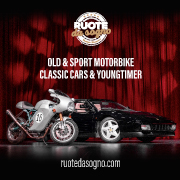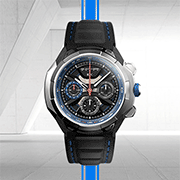In late 1999, long before the phenomenon of resto-modding, or "backdating" Porsche 911s would evolve into today's multi-million-dollar industry, one particular build emerged that would prove prescient of things to come. The landscape for air-cooled Porsches was vastly different thenâa 1973 911 T was simply considered a used sports car, often plagued by the long-hood model's infamous propensity for rust that frequently rendered these now-desirable classics into parts cars or worse. Therefore, when this particular non-running, yet remarkably rust-free 1973 911 T Coupe surfaced at Jeff Gamrothâs Rothsport Racingâan experienced West Coast Porsche mechanic and fabricator with a background in PCA, SCCA, and ALMS competitionâthe decision was taken to transform it into a lightweight, reliable street car that could hold its own against modern machinery. The story began when one of Gamrothâs clients, Page Stevens, noticing the bare shell in the corner of the Rothsport shop, inquired about its future. What he learned piqued his interest: plans for a lightweight RS-style street machine with bulletproof reliability. As discussions progressed, Stevenâs desire for the ultimate in road-going 911 performance elevated the scope of the project. The build centered around a 993-sourced powerplant, enhanced with a 200 cc gain in displacement to 3.8-liter Euro RS specifications. The powerplant was further upgraded with competition-specification components throughout, including VarioRam cylinder heads and stock valves prepared by Dick Elverud at Northwest Machine, matched with larger-bore Mahle pistons and cylinders. Carrillo forged rods, ARP rod bolts, as well as racing valve springs and titanium retainers by Aasco were also enlisted. A 993 camshaft package reprofiled to 3.8 RS specifications by Web Cam optimized the engine's breathing characteristics, while a specially modified 3.6-liter flywheel by Patrick Motorsports and Sachs Sport clutch assembly ensured optimal power transfer to the close-ratio, aluminum 915 transmission. Delivering a linear power band tailored specifically for Stevenâs intended dual track and street use, the first gear provided 47 mph, second reached 72 mph, third 97 mph, fourth delivered 122 mph, and fifth gear was capable of pushing to 175 mph. The task of fitting this modern drivetrain necessitated thoroughly reworking the 911 Tâs chassis and thermal management. This involved a twin-cooler setup with a front-mounted Fluidyne oil cooler housed in the battery box working in concert with an additional Setrab cross-flow oil cooler integrated into the RS-style front bumper, while a factory thermostat and custom-made lines and fittings ensured optimal operating temperatures. The exhaust system featured 1.75 inch headers from European Racing, culminating in a modified dual-inlet/dual-outlet racing muffler from Flowmaster with specially engineered centerline-exit tailpipes. The original fuel tank was thoughtfully replaced with a lightweight 21.1-gallon Carrera unit for uncompromised weight reduction. The chassis received an equally thorough overhaul, with particular attention paid to managing the car's remarkably light 2,250-pound weight. Seven by 15-inch front, and 9 by 15-inch rear Fuchs wheels were selected for their optimal combination of width and weight, requiring careful narrowing of the trailing arms and modification of the axles to retain the narrow-body RS stance. To accommodate the lowered ride height, custom-valved Bilstein struts featuring a 17mm offset were fitted up front, joined by custom lightweight Moton racing shocks out back. The extended-width stance was also managed by custom-fabricated suspension hardware, including a substantial 24 mm under-body front anti-roll bar, 22 mm rear anti-roll bar in urethane bushings, and Sander Engineering front and rear hollow torsion bars. Gamroth's custom-machined brake calipers from a 1979 911 Turbo worked in concert with the upgraded suspension geometry to deliver exceptional stability and stopping power under aggressive cornering loads. The cosmetic transformation showcases the same obsessive approach to detail and weight reduction, incorporating steel factory flares, fiberglass RS-style front and rear bumpers, and a rear RS ducktail spoiler from Getty Design, all renewed in classic Signal Yellow (114). All brightwork was deleted in favor of black trim, including the 993 rear quarter-glass seals, while the lightweight rear window was sourced from a 1967 912. Hardware like the hinges and latches that are normally zinc-plated were treated to nickel plating. The black interior was methodically stripped of all sound deadening and fitted with special thin carpets by Original Fit Interiors, complemented by a MOMO suede steering wheel. Lightweight RS America door panels with their signature red door pulls were fitted, while Recaro Pole Position competition seats with Schroth five-point harnesses provided both cornering support and safety. Once completed, testing revealed performance figures eclipsing those of period RS examples, with Gamroth describing the final product as âStaggeringâyou can get it sideways in the lower three gears. It stirs the sensesâit's the essence of a 911, with all the throttle response and handling characteristics you could ever want while retaining a smooth, quiet ride in traffic.â The 911 was later featured in a June 2003 issue of Excellence magazine chronicling the recent build and thus charting the path for all future air-cooled restomods. After 15 years and three further owners, the pioneering 911 returned to Gamrothâs shop, then under the stewardship of the current owner in Los Angeles. In the spirit of the initial build, the current owner and Gamroth elected to further refine the car with a focus on balanced performance and touring capability. The engine was upgraded with a 3.8 RSR intake manifold, Rothsport's six individual throttle bodies, and a modified 996 GT3 resonant plenum, all managed by Motec M84 engine management. The engine now produces 335 horsepower, delivering what Gamroth describes as "instantaneous throttle response." For grand touring purposes, the car received comprehensive comfort upgrades including a U.K.-sourced Classic Retrofit electric A/C system, electric seat heaters, intermittent windshield wipers, and a modern audio system with Bluetooth/iPhone connectivity and high-end door speakers. Touring capability was further enhanced with Toyo 215/50 and 235/50-15 888R tires, while practical additions included a battery cutoff switch, 964 space-saver spare, air compressor, tool kit, and a Bilstein jack. The car has proven its dual-purpose nature through successful participation in the Montana Ramshorn "Going to the Sun" Rally in 2018 and 2019, accumulating approximately 6,000 miles since its refurbishment. This extraordinary build represents Stevens' vision of what a classic 911 could be, combined with Gamrothâs countless hours of development and engineering expertise, resulting in a machine that captures the essence of Porsche's legendary RS while incorporating thoughtful improvements throughout. Where today's 911 resto-mods might prioritize heritage or collector appeal, this project was focused solely on creating the most technically advanced street car possible that could deliver contemporary performance while maintaining the essence of a classic 911.
- Fuel
- Body Types
- Transmission
- Exterior Colour
- Number of doors
- Interior Colour
- VIN Code9113500679






































































































































































































